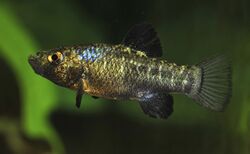Biology:Cyprinodon desquamator
| Cyprinodon desquamator | |
|---|---|

| |
| Scientific classification | |
| Domain: | Eukaryota |
| Kingdom: | Animalia |
| Phylum: | Chordata |
| Class: | Actinopterygii |
| Order: | Cyprinodontiformes |
| Family: | Cyprinodontidae |
| Genus: | Cyprinodon |
| Species: | C. desquamator
|
| Binomial name | |
| Cyprinodon desquamator C. H. Martin & Wainwright, 2013
| |
Cyprinodon desquamator is a scale-eating species of pupfish in the genus Cyprinodon. It is endemic to hypersaline interior lakes on San Salvador Island, Bahamas. It coexists alongside two other closely related Cyprinodon species C. brontotheroides and C. variegatus. Together, these three species represent a recent adaptive radiation,[2] each having moved into a difference niche within their specialized environment. Each of these species are defined by distinct trophic adaptations that have affected various aspects of their functional morphology,[3][4] behavior,[5] strike kinematics,[6] and reproductive coloration.[7]
Cyprinodon desquamator has enlarged adductor muscles, a small in-lever to out-lever ratio for rapidly closing its large lower jaw, and an elongated body for quickly performing scale-removing strikes on Cyprinodon and Gambusia species.[8] This species spawns during the spring and summer, although it appears to be commoner in the summer. The males guard breeding territories.[9]
Specific epithet: 'desquamator' comes from the Latin "one who removes scales from fishes", describing the scale-eating trophic specialization of this species, unique among Cyprinodontiform fishes.[10][11]
Coloration
General body color is silvery tan marked by irregular dark, wide bars along the length of the body in both sexes. Characteristic of the genus, mature males display a metallic blue anterodorsal region. This species uniquely lacks the typical black terminal margin to the caudal fin, which is replaced by black pigmentation covering the median fins.
Females and juveniles display the typical black and white ocellus on the dorsal fin. Breeding males display a distinctive coloration of slate gray to jet black pigmentation throughout body and fins, broken only by a speckling of metallic blue in the anterodorsal region. Unlike most congeners, breeding males do not display any orange ventral coloration that is replaced by gray or black pigmentation.[10]
References
- ↑ Lyons, T.J. (2021). "Cyprinodon desquamator". IUCN Red List of Threatened Species 2021: e.T82958628A82962216. doi:10.2305/IUCN.UK.2021-1.RLTS.T82958628A82962216.en. https://www.iucnredlist.org/species/82958628/82962216. Retrieved 9 November 2022.
- ↑ Martin, Christopher H.; Wainwright, Peter C. (2011-04-11). "Trophic Novelty is Linked to Exceptional Rates of Morphological Diversification in Two Adaptive Radiations of Cyprinodon Pupfish". Evolution 65 (8): 2197–2212. doi:10.1111/j.1558-5646.2011.01294.x. ISSN 0014-3820. PMID 21790569.
- ↑ Martin, Christoper (11 January 2013). "Multiple Fitness Peaks on the Adaptive Landscape Drive Adaptive Radiation in the Wild". Science 339 (6116): 208–211. doi:10.1126/science.1227710. PMID 23307743. Bibcode: 2013Sci...339..208M. https://www.science.org/doi/full/10.1126/science.1227710.
- ↑ Hernandez, Luz Patricia; Adriaens, Dominique; Martin, Christopher H.; Wainwright, Peter C.; Masschaele, Bert; Dierick, Manuel (2017-11-21). "Building trophic specializations that result in substantial niche partitioning within a young adaptive radiation". Journal of Anatomy 232 (2): 173–185. doi:10.1111/joa.12742. ISSN 0021-8782. PMID 29161774.
- ↑ St. John, Michelle E.; McGirr, Joseph A.; Martin, Christopher H. (2018-03-11). Testing the behavioral origins of novelty: did increased aggression lead to scale-eating in pupfishes?. doi:10.1101/280123. http://dx.doi.org/10.1101/280123. Retrieved 2021-02-10.
- ↑ St. John, Michelle E.; Holzman, Roi; Martin, Christopher H. (2019-05-24). Rapid adaptive evolution of scale-eating kinematics to a novel ecological niche. doi:10.1101/648451.
- ↑ Martin, Christopher H.; Erickson, Priscilla A.; Miller, Craig T. (2016-12-26). "The genetic architecture of novel trophic specialists: larger effect sizes are associated with exceptional oral jaw diversification in a pupfish adaptive radiation". Molecular Ecology 26 (2): 624–638. doi:10.1111/mec.13935. ISSN 0962-1083. PMID 27873369. http://dx.doi.org/10.1111/mec.13935.
- ↑ Martin, C.; P.C. Wainwright (2011). "Trophic novelty is linked to exceptional rates of morphological diversification in two adaptive radiations of Cyprinodon pupfish". Evolution 65 (8): 2197–2212. doi:10.1111/j.1558-5646.2011.01294.x. PMID 21790569.
- ↑ Froese, Rainer and Pauly, Daniel, eds. (2019). "Cyprinodon desquamator" in FishBase. August 2019 version.
- ↑ 10.0 10.1 "Archived copy". http://www.eve.ucdavis.edu/~wainwrightlab/Martin%26WainwrightPeabody2013.pdf.
- ↑ Martin, Christopher H.; Wainwright, Peter C. (2013-08-19). "On the Measurement of Ecological Novelty: Scale-Eating Pupfish Are Separated by 168 my from Other Scale-Eating Fishes". PLOS ONE 8 (8): e71164. doi:10.1371/journal.pone.0071164. ISSN 1932-6203. PMID 23976994. Bibcode: 2013PLoSO...871164M.
Wikidata ☰ Q20826779 entry
 |


